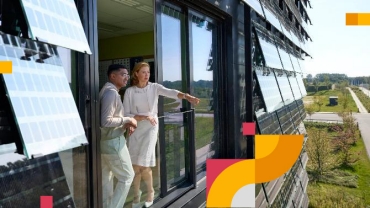
Decarbonizing aviation one step closer with new guidelines
17/10/22
Standardized emissions reporting promises proliferation of SAF and SAFc
Decarbonizing hard-to-abate sectors, such as aviation, is a difficult task. Difficult, but essential. Sustainable Aviation Fuel (SAF) plays a key role in decarbonizing aviation. Clean Skies for Tomorrow and PwC now propose a standardized approach to not only decarbonize air travel, but also make it possible to consistently and transparently account for the environmental benefits of SAF and SAFc.


Karin Meijer
‘One of the problems of SAF is that it is significantly more expensive than conventional jet fuel’, says Karin Meijer, partner ESG Services, PwC and an expert in ESG-reporting. With the publication of SAFc Emissions Accounting and Reporting Guidelines, Clean Skies for Tomorrow (CST) and PwC are taking the next step in designing a standardized approach to accounting and reporting.
‘Since SAFc is a newly introduced tool, it lacks accurate and consistent accounting and reporting standards’, Meijer adds. Those two essential problems made it quite unattractive to use SAF, allowing SAF to account for less than 0.1 per cent in total fuel demand.
Accounting guidelines to accounting carbon emissions
‘Luckily, that is a thing of the past’, says Wineke Haagsma, chief sustainability officer at PwC. ‘This new report, following our partnership with the World Economic Forum and the CST-initiative, is detailing the accounting guidelines to accounting carbon emissions. That is a vital step to unlocking long-term investment and creates insights for integration of Sustainable Aviation Fuels credits in the accounting standards’.
‘Last year, we launched the concept, this year we make it possible to take concrete action. Therefore, I am convinced that these developments and this milestone will increase the incentive to use SAF’, Haagsma says.
With a view to its wider adoption, CST is supporting the aviation value chain to catalyze demand for additional supply of SAF. Together with its partners, CST has developed a market-based mechanism that more actors can contribute which eventually can lead to bringing down this premium price, thus advancing the SAF market.

Wineke Haagsma
Time to start decarbonizing value chains
‘In order to scale, the market needs clarity on how SAF and SAFc can be accurately and consistently accounted for. First and foremost, it is critical that the environmental attributes of SAF are accounted for accurately and aren’t erroneously double or triple counted’, says Sohaib Arshad, manager within PwC's ESG team focusing on climate change and sustainability reporting. The SAFc market mechanism, which will function similarly to the well-established virtual accounting method of Energy Attribute Certificate (EAC), represents the environmental attributes of a tonne of unblended SAF.
There is significant demand from business aviation customers - both for their business travel and freight - for tangible solutions to address the problem. SAFc can leverage this demand to scale up production of SAF faster and enable more actors to start decarbonizing their value chains. This market mechanism can provide consumers with a tool to receive a meaningful demand signal to the emerging SAF market.

Use of SAF and SAFc requires accurate accounting and reporting
Sustainable fuel, it almost sounds too good to be true. ‘Of course, not flying at all would be the best possible solution for the environment’, Haagsma admits instantly. Meijer agrees, it is a dilemma, because a global economy without aircrafts and air traffic is hard to imagine. And within that context, we must make every effort to bring the most sustainable choices within reach.’
The procurement and use of SAF and SAFc requires accurate accounting and reporting.
Standards on GHG emissions accounting already exist and guide accounting and reporting today. However, as SAFc is a novel accounting and reporting tool, minor modifications to existing accounting approaches are proposed that deviate from current practices in order to accurately and consistently reflect its distinct characteristics.
Two key reasons why accurate accounting is so important in achieving a net zero aviation sector:
- void duplications or multiple counts which can create lack of transparency and traceability. This can undermine stakeholder confidence.
- Standardized accounting and reporting practices can reduce risks in the SAF certificate market. These will ensure that SAF and SAFc users are allocated accurate and proportionate emissions and reductions.
Instructions for multiple stakeholders in the aviation value chain
While there has been considerable interest in SAF and SAFc, the aviation value chain eagerly awaited clarity on a standardized accounting and reporting approach. Stakeholders agreed that such a framework could enable cost sharing, encourage investment in production capacity and ultimately promote the use of renewable fuels.
The proposed accounting and reporting guidelines within the new 2022-guidelines are intended to provide guidance to technical practitioners, including emissions inventory specialists, auditors, fuel suppliers and business purchasers of SAF and SAFc. To effectively serve the readership, it provides detailed step-by-step instructions for stakeholders throughout the aviation value chain, including inventory limits, accounting and reporting treatments and sample calculations. Besides, the guidance covers a wide range of customer stakeholders, including SAF suppliers, airlines, business travelers, private aircraft owners and operators, and cargo carriers.
Another accounting standard, it really is necessary
The Greenhouse Gas Protocol (GHGP) and the Science Based Targets Initiative (SBTi) address many aspects of SAF and SAFc accounting. Therefore, the SAFc accounting and reporting guidelines actively use existing standards.
‘Clients ask us why an additional guideline is needed, on top of the well-known standards’, says Haagsma. ‘The CST-accounting and reporting guidelines are intended to improve the completeness, relevance, transparency, consistency, and accuracy of the existing accounting and reporting standards. Together with other esteemed members of CST, we are working to integrate SAFc into the broader corporate emissions reporting guidelines and frameworks. We hope that this guidance will eliminate market uncertainty and promote understanding and alignment.’
Meijer and Arshad are delighted with the new developments because SAFc enables multiple parties, including those who don’t use fuel in their operations, to contribute towards decarbonisation efforts. Arshad: ‘For instance, for businesses operating in the service sector, it is the only practical approach to materially contribute to the decarbonisation of aviation. That’s a huge step forward.’























